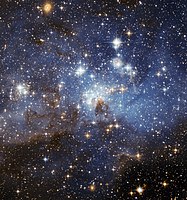
Photo from wikipedia
We explored a suite of high-resolution cosmological simulations from the First Billion Years Project (FiBY) at $z \geq 6$. All substructures within the simulations have been identified with the SUBFIND… Click to show full abstract
We explored a suite of high-resolution cosmological simulations from the First Billion Years Project (FiBY) at $z \geq 6$. All substructures within the simulations have been identified with the SUBFIND algorithm. From our analysis, two distinct groups of objects emerge. We hypothesise that the substructures in the first group, which appear to have a high baryon fraction ($f_{\rm b} \geq 0.95$), are possible infant GC candidates. Objects belonging to the second group have a high stellar fraction ($f_{\rm star} \geq 0.95$) and show a potential resemblance to infant ultra-faint dwarf galaxies. The high baryon fraction objects identified in this study are characterised by a stellar content similar to the one observed in present-day GCs, but they still contain a high gas fraction ($f_{\rm gas} \sim 0.95$) and a relatively low amount of dark matter. They are compact, dense systems. Their sizes are consistent with recent estimates based on the first observations of possible proto-GCs at high redshifts. These types of infant GC candidates appear to be more massive and more abundant in massive host galaxies, indicating that the assembly of galaxies via mergers may play an important role in building several GC-host scaling relations. Specifically, we express the relation between the mass of the most massive infant GC and its host stellar mass as $\log(M_{\rm cl}) = (0.31\pm0.15)\log(M_{\rm *,gal} + (4.17\pm1.06)$. We also report a new relation between the most massive infant GC and the parent specific star formation rate of the form $\log(M_{\rm cl}) = (0.85\pm0.30)\log(sSFR) + \alpha$ that describes the data at both low and high redshift. Finally, we assess the present-day GC mass (GC number) -- halo mass relation offers a satisfactory description of the behaviour of our infant GC candidates at high redshift, suggesting that such a relation may be set at formation.
Journal Title: Astronomy and Astrophysics
Year Published: 2020
Link to full text (if available)
Share on Social Media: Sign Up to like & get
recommendations!